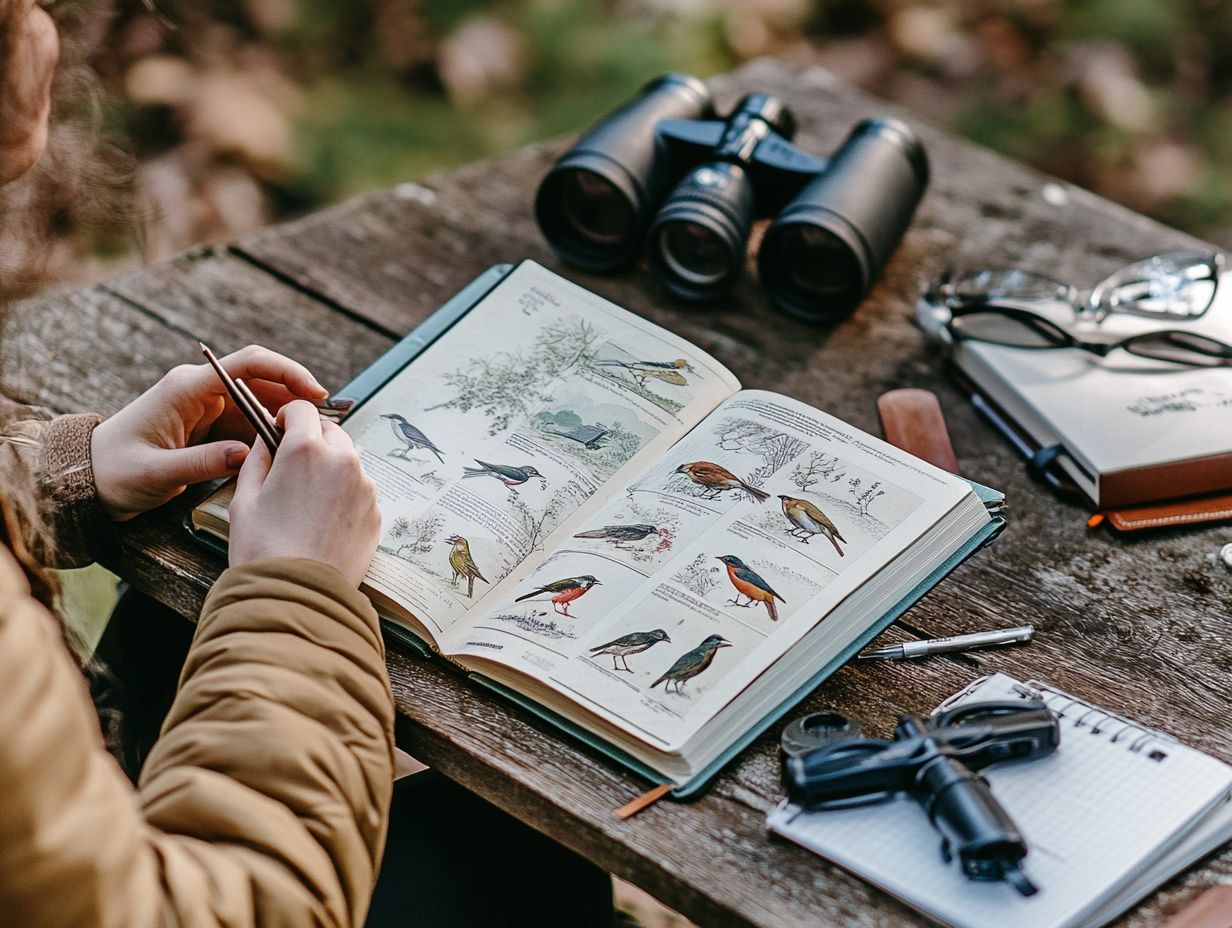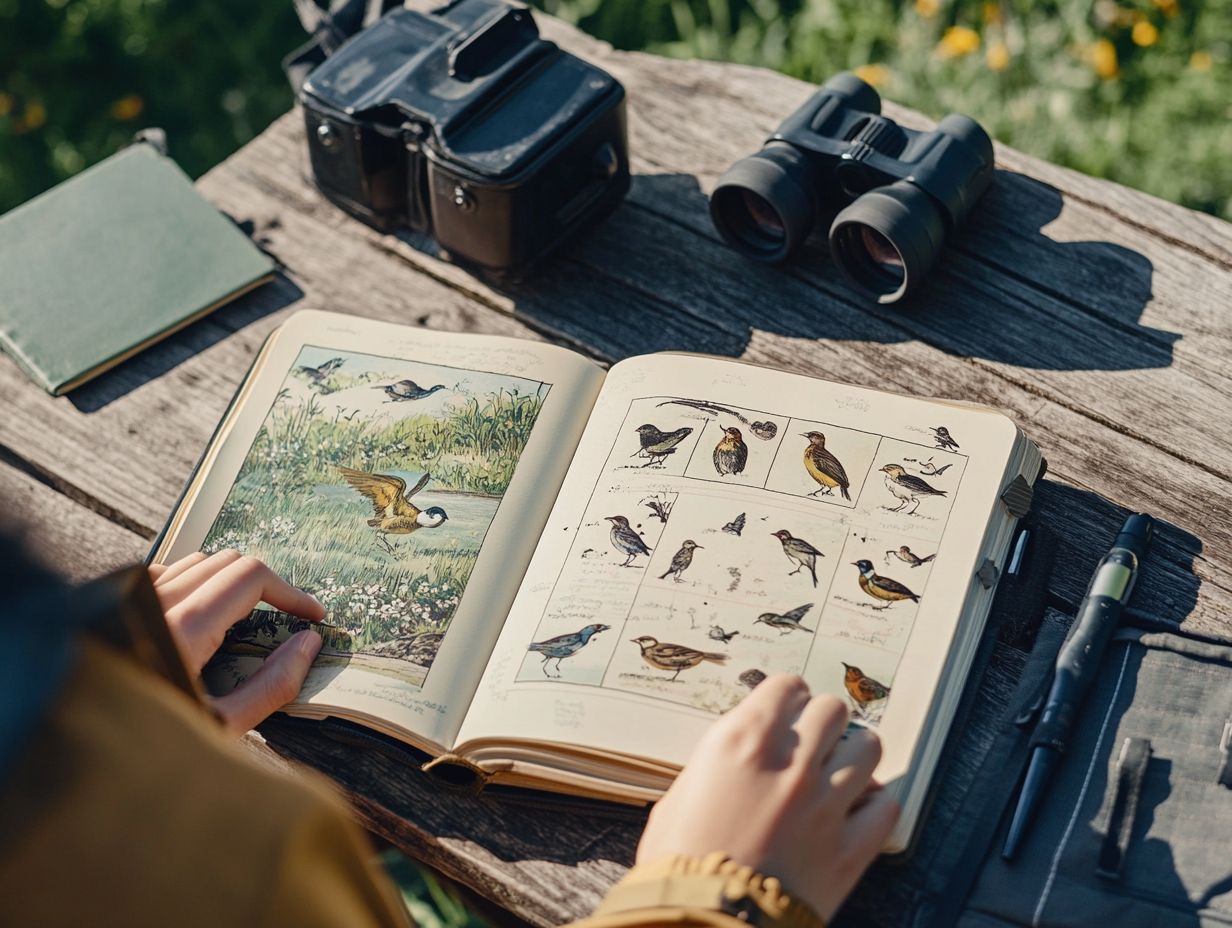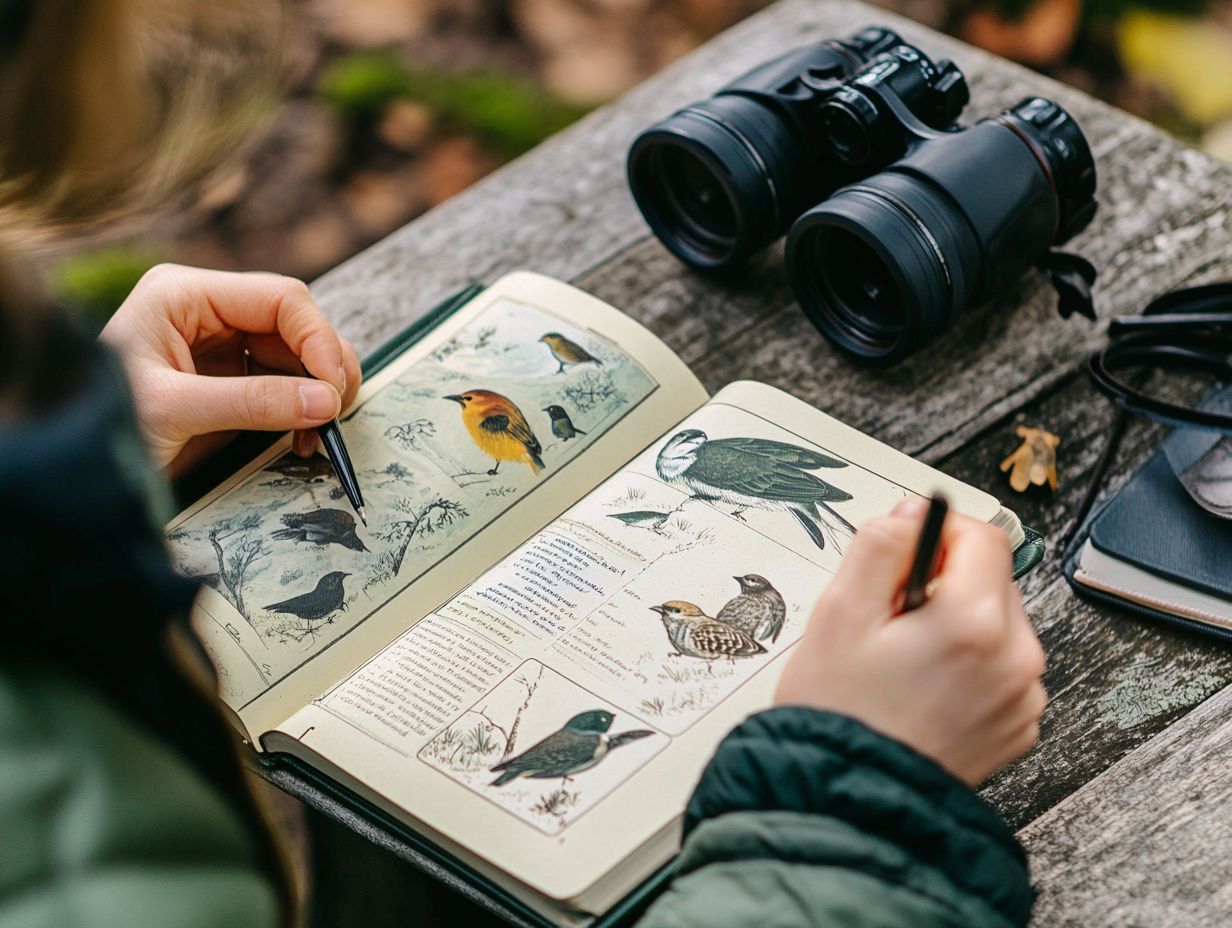Identifying Bird Species: Tips from Field Guides
Birdwatching is a rewarding hobby that beautifully connects you with nature. However, accurately identifying species can sometimes feel like navigating a maze.
This article explores the importance of using field guides for bird identification, showcasing their myriad benefits and features.
You will discover key physical traits and behaviors to observe, along with common identification pitfalls and strategies to sidestep them.
Get ready to elevate your skills! You will find valuable resources, including websites and apps, to enrich your birdwatching experience and immerse yourself even deeper in this captivating pursuit!
Contents
- Key Takeaways:
- The Importance of Accurate Identification
- Using Field Guides for Bird Identification
- Key Characteristics to Look for
- Common Mistakes in Bird Identification
- Resources for Further Learning
- Frequently Asked Questions
- How Can You Easily Identify Birds with Field Guides?
- Are There Tips for Using Field Guides to Identify Birds?
- Do All Bird Species Have Distinct Field Guide Entries?
- Can Field Guides Help with Identifying Bird Species Based on Their Songs?
- Are There Field Guides Specifically for Certain Regions or Countries?
- Is There a Recommended Field Guide for Beginners in Bird Identification?
Key Takeaways:
- Accurate identification of bird species is crucial for conservation and research efforts.
- Field guides provide valuable information and visual aids for bird identification.
- Look for physical features and behaviors while avoiding common mistakes.

The Importance of Accurate Identification
Accurate bird identification is essential for both novice and seasoned birdwatchers. It elevates your appreciation and understanding of avian life. Whether you’re captivated by the striking Scarlet Tanager or the ever-familiar American Robin, mastering the art of identifying various bird species unlocks a richer experience of their behaviors, habitats, and roles within ecosystems.
With the right resources at your disposal, such as field guides and mobile apps, you can refine your ability to recognize key characteristics like shape and color, which are vital for bird identification throughout North America.
Using Field Guides for Bird Identification
Field guides are essential companions for birdwatchers. They provide comprehensive insights into bird identification and behavior, enhancing your ability to recognize diverse species in their natural habitats.
By leveraging well-regarded resources like the Kaufman Field Guide or the Merlin Bird ID app, you gain access to a treasure trove of visual aids stunning illustrations and photographs paired with essential details about each bird s key features, habitats, and behaviors.
These guides elevate your birdwatching adventures, enabling you to identify species and savor their unique attributes like never before. For a deeper insight, consider understanding the layout of bird field guides.
Benefits and Features of Field Guides
Field guides offer a wealth of advantages for you as a birdwatcher. They equip you with essential features that enhance your bird identification and observation experience. These guides showcase visual representations of various bird species, emphasizing critical aspects such as field marks, body parts, and behaviors crucial for accurate identification.
Whether you prefer a traditional book or a sleek field guide app, these resources simplify the art of identifying birds, transforming it into an enjoyable pursuit for enthusiasts at any skill level.
Beyond their compact size, which ensures easy portability during your outdoor adventures, many guides boast detailed illustrations and photographs that will captivate both novice and seasoned birdwatchers alike. You can effortlessly compare similar species side by side, effectively eliminating confusion during sightings.
Many mobile apps take your experience to the next level. They feature audio calls to help you familiarize yourself with bird songs and interactive tools that allow you to log your observations in real-time.
These innovations ensure that your exploration of nature becomes a rich and educational journey, revealing the stunning beauty of avian life in a way that is both engaging and accessible.
Key Characteristics to Look for

To effectively identify birds, you must recognize key characteristics that set different species apart. Observing attributes like size, shape, color, and distinctive field marks can offer invaluable clues for your identification efforts, and using popular bird field guides among experienced birders can enhance your skills further.
Additionally, grasping the nuances of bird topography which refers to the physical structure of birds such as wing shape and tail structure, along with behavioral traits like feeding habits and song patterns, will greatly enhance your ability to recognize a variety of bird species across North America.
Physical Features and Behaviors to Note
Identifying different bird species in the wild requires attention to physical features and behaviors. Key features like feather shape, color, body size, and unique parts such as beaks and feet vary significantly across species.
Observing behaviors like feeding habits, flight patterns, and vocalizations offers essential context for identification.
Take the Wood Thrush, for instance. Its melodic song is a key identifying feature that resonates through dense woodlands during the breeding season.
On the other hand, the Dark-eyed Junco s distinctive feeding pattern makes it easy to spot among fallen leaves.
By focusing on these exciting behaviors, you can really boost your ability to tell different species apart.
Common Mistakes in Bird Identification
Common mistakes in bird identification can significantly detract from your experience, whether you’re a novice or a seasoned birdwatcher. Misidentifications often lead to unnecessary frustration.
Many of these errors stem from oversimplifying key characteristics. Relying solely on color while neglecting size and shape variations can lead to confusion.
By recognizing these pitfalls, you can enhance your identification skills and elevate your birdwatching expeditions.
Whether you prefer a traditional field guide or an app like the Audubon app, being mindful of these nuances ensures a more rewarding experience in the field.
How to Avoid Common Pitfalls
To avoid common pitfalls in bird identification, adopt specific strategies that enhance your observational skills and minimize errors. One effective approach is to take a systematic view of the bird’s physical features, considering its shape, size, and distinctive field marks rather than focusing solely on color, which can often be misleading. Additionally, learning about birdwatching ethics with field guides can further improve your birdwatching experience.
Utilizing field guides and apps like Merlin Bird ID can provide valuable support in verifying your observations and ensuring accurate identification.
It’s essential to observe birds in different postures and from varying distances, as these factors can significantly alter their appearance. Keeping a field journal can enhance your awareness, encouraging you to jot down detailed notes and sketches that capture unique characteristics.
Joining local birdwatching groups offers invaluable opportunities for shared experiences and diverse insights.
By combining your personal observations with expert opinions and varied resources, you can sharpen your skills and increase your confidence in identifying different species. This multi-faceted approach not only enriches your birdwatching experience but also fosters a deeper appreciation for avian wildlife.
Resources for Further Learning

For anyone eager to elevate their understanding of bird identification, a wealth of resources awaits to enrich your learning experience. Websites like All About Birds and the Audubon Center offer extensive insights into various bird species, effective identification techniques, and vital conservation efforts.
Moreover, mobile apps such as the Audubon app and Merlin Bird ID present interactive learning opportunities, enabling you to hone your skills in recognizing and appreciating the rich diversity of avian life.
Websites, Apps, and Other Tools
Websites and mobile apps have become essential tools for bird identification, offering resources that are both informative and user-friendly. Platforms like All About Birds and mobile applications such as Merlin Bird ID simplify the identification process by providing extensive databases of bird species and interactive quizzes.
These tools promote community engagement, enabling you to sharpen your skills and deepen your appreciation for the avian world.
Platforms like BirdNet and iNaturalist elevate your experience with smart sound recognition tools and user-generated observations. You can upload photos or recordings, allowing everyone to learn together while gaining insights from seasoned bird enthusiasts.
Interactive maps enable you to locate specific bird species in your area. This transforms birdwatching from a solitary endeavor into a shared adventure.
Ultimately, these digital resources are revolutionizing the way you connect with nature, ensuring that birdwatching remains accessible and engaging, regardless of your skill level. Don t miss out on the chance to enhance your bird identification skills today!
Frequently Asked Questions
How Can You Easily Identify Birds with Field Guides?
The best way to identify bird species using field guides is to first observe the bird’s physical characteristics, such as size, color, and beak shape. Then, consult a field guide for birds in your area and match these characteristics to the images and descriptions provided. For a deeper insight, consider understanding bird behavior with field guides.
Are There Tips for Using Field Guides to Identify Birds?

Yes, there are a few helpful tips for using field guides to identify birds. For a deeper dive, consider understanding bird identification with field guides. Pay close attention to the bird’s habitat, behavior, and call, as these can also provide clues for identification.
Consider using multiple field guides to cross-reference your findings.
Do All Bird Species Have Distinct Field Guide Entries?
No, not all bird species have distinct field guide entries. Some species, such as gulls and sparrows, can be tricky to differentiate and may require more in-depth observation and research. When selecting a guide, it’s helpful to know the top features to look for in a bird field guide to aid in accurate identification.
Can Field Guides Help with Identifying Bird Species Based on Their Songs?
Yes, many field guides include descriptions and audio recordings of bird songs. Listening to a bird’s song can provide important clues for identification, especially for species that look similar.
Are There Field Guides Specifically for Certain Regions or Countries?
Yes, there are field guides specifically for certain regions or countries. These guides may include a more comprehensive list of bird species found in that area and may also provide additional information on their behavior and habits.
Is There a Recommended Field Guide for Beginners in Bird Identification?
For beginners, it is recommended to start with a simple and easy-to-use field guide. Consider using one of the top 10 field guides for identifying sparrows, as they feature clear images and descriptions that cover common bird species in your area.
Some popular options include the Peterson Field Guides and the National Geographic Field Guide to Birds of North America.
Start your birdwatching journey today! Check out these fantastic tools that will enhance your experience.






